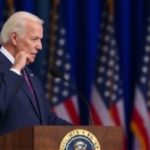As the U.S. Government shutdown stretches into its 34th day, matching the record set in 2018-2019, the nation faces unprecedented disruptions to daily life and the broader economy. Senators have returned to Washington, D.C., amid mounting pressure, but bipartisan talks show no signs of resolution over border security funding, leaving federal workers unpaid and essential services in jeopardy. This prolonged lapse in federal funding has triggered long lines at food distribution sites across the country and widespread chaos at airports, fueling fears of a deepening recession in the U.S. economy.
Senators Resume Talks in D.C., Stalemate Persists Over Border Wall Funding
With the shutdown now tying the longest in American history, a weary group of senators trickled back to the Capitol on Monday, hoping to break the impasse that has paralyzed federal operations since December 22. Democratic Leader Chuck Schumer and Republican Leader Mitch McConnell exchanged tense pleasantries in the Senate chamber, but sources close to the negotiations indicate that core disagreements remain entrenched. The primary flashpoint: President Donald Trump’s demand for $5.7 billion in federal funding for a southern border wall, which Democrats view as an unnecessary and divisive expense.
“This isn’t just about a wall; it’s about the future of our democracy and how we allocate taxpayer dollars,” Schumer declared during a morning briefing, emphasizing the need for comprehensive immigration reform over piecemeal border fortifications. On the other side, McConnell reiterated the administration’s stance, quoting White House officials who argue that enhanced border security is essential for national safety. “We can’t ignore the humanitarian and security crises at our borders,” he said, pointing to recent migrant surges as justification.
Behind closed doors, informal discussions have involved key figures like Sen. Lindsey Graham (R-S.C.) and Sen. Dick Durbin (D-Ill.), but progress is elusive. A bipartisan group of moderates proposed a short-term funding bill to reopen the government while negotiations continue, but it faces resistance from hardliners on both aisles. As of Tuesday afternoon, no vote is scheduled, leaving the shutdown’s fate hanging in the balance. The delay has already cost the U.S. economy an estimated $11 billion in lost productivity, according to the Congressional Budget Office, with daily losses compounding at over $300 million.
This political gridlock isn’t new—shutdowns have occurred 21 times since 1976—but the current one stands out for its duration and scope, affecting 800,000 federal employees and countless contractors. Furloughed workers, from IRS auditors to national park rangers, are resorting to food pantries and credit cards to make ends meet, highlighting the human stakes in this fiscal standoff.
Airport Chaos Escalates as TSA Agents Work Without Pay
At major airports nationwide, the ripple effects of the Government shutdown are most visibly chaotic, with security lines stretching for hours and frustrated travelers voicing their discontent. The Transportation Security Administration (TSA), operating on borrowed time without federal funding, has seen absenteeism rates climb to 10% among its 50,000 screeners, many of whom are calling in sick to seek second jobs or cope with personal hardships.
John F. Kennedy International Airport in New York reported average wait times of 45 minutes at checkpoints on Monday, up from 20 minutes pre-shutdown, leading to missed flights and heated exchanges. “It’s a nightmare,” said passenger Maria Gonzalez, a business traveler from Chicago, as she waited in line at O’Hare International. “We’re paying taxes for this service, and now it’s crumbling because politicians can’t agree.” Similar scenes unfolded at Los Angeles International and Atlanta’s Hartsfield-Jackson, the world’s busiest airport, where delays have cascaded into broader travel disruptions.
TSA Administrator David Pekoske acknowledged the strain in a statement, noting that while the agency is committed to maintaining security, the lack of paychecks is taking a toll. “Our workforce is dedicated, but no one can work indefinitely without compensation,” he said. To mitigate the crisis, the TSA has implemented “minimum staffing” protocols, but critics argue this compromises safety. The Air Line Pilots Association warned of potential fatigue-related incidents, citing a recent near-miss at Reagan National Airport in Washington.
Beyond immediate delays, the shutdown’s impact on airports extends to maintenance and air traffic control. The Federal Aviation Administration, partially funded through user fees, is strained, with some towers operating at reduced capacity. Travel industry analysts estimate that the disruptions have already shaved $1.2 billion off airline revenues this month, with ripple effects hitting hotels and tourism sectors hard. As the shutdown drags on, experts predict even longer lines and possible flight cancellations, exacerbating the chaos at these critical gateways to the U.S. economy.
Food Distribution Sites Overwhelmed Amid Federal Program Freeze
The Government shutdown‘s fallout is hitting hardest at the grassroots level, where food distribution sites are swamped with unprecedented demand from furloughed federal workers and low-income families reliant on paused assistance programs. In cities like Detroit and Miami, lines have formed that snake around blocks, as organizations scramble to fill the void left by halted federal funding for programs like SNAP (Supplemental Nutrition Assistance Program) and WIC (Women, Infants, and Children).
Feeding America, a national network of food banks, reported a 25% surge in visits since the shutdown began, with over 1.5 million additional meals distributed in the past week alone. “We’re seeing federal employees who never imagined they’d need this help,” said CEO Claire Babineaux-Fontenot. In Washington, D.C., a local pantry served 500 people on a single day—double its usual volume—including IRS agents and Smithsonian staffers. One volunteer, retired teacher Elena Ramirez, described the scene: “Mothers with crying children, veterans without checks—it’s heartbreaking. The shutdown isn’t just numbers; it’s empty refrigerators.”
The freeze on federal funding has suspended inspections and administrative support for these programs, forcing states to dip into emergency reserves. In California, where 4 million residents depend on CalFresh (the state’s SNAP equivalent), officials have extended benefits through borrowed funds, but sustainability is questionable. Nutrition experts warn of rising malnutrition risks, particularly among children, with the USDA estimating that 40,000 women and children could lose WIC access if the shutdown persists another week.
Compounding the issue, farm aid programs are stalled, leaving agricultural communities vulnerable. Midwestern farmers, already battered by trade wars, are delaying shipments due to unpaid inspectors, which could drive up food prices nationwide. Advocacy groups like the National WIC Association are urging Congress to prioritize humanitarian aid in any resolution, but with talks stalled, food distribution sites brace for worse. This crisis underscores how the government shutdown is eroding the safety nets that millions rely on, turning a political dispute into a tangible hunger emergency.
U.S. Economy Feels Mounting Pressure from Prolonged Shutdown
The U.S. economy, already navigating inflation concerns and global trade tensions, is buckling under the weight of the 34-day government shutdown, with economists projecting a 0.2% GDP hit in the first quarter of 2024. Consumer confidence indices have plummeted, with the Conference Board’s February reading dropping to 95.8—its lowest since the pandemic— as uncertainty over federal funding sows doubt among businesses and households alike.
Wall Street reflected the gloom, with the Dow Jones Industrial Average dipping 1.5% on Monday amid fears of delayed tax refunds and stalled infrastructure projects. Small businesses, particularly those dependent on government contracts, are reeling; the National Federation of Independent Business reports that 20% of its members have laid off workers due to cash flow issues. In the tech sector, Silicon Valley firms awaiting National Science Foundation grants have halted R&D initiatives, potentially stifling innovation.
Federal Reserve Chair Jerome Powell addressed the shutdown in a recent speech, cautioning that while the economy’s fundamentals remain solid, prolonged disruptions could tip it toward recession. “The shutdown is like a drag on an otherwise revving engine,” he analogized, estimating that every additional week could cost 10,000 jobs. Labor statistics show unemployment ticking up to 4.1%, with federal workers accounting for a disproportionate share of new claims.
Regionally, the impacts vary but are acute. Coastal states suffer from tourism slumps at understaffed national parks, while heartland economies grapple with frozen agricultural subsidies. Retailers like Walmart and Amazon report softer sales as consumers tighten belts, fearing delayed refunds worth $200 billion annually. International observers, including the IMF, have downgraded U.S. growth forecasts, warning that the government shutdown could undermine global confidence in American stability.
As the impasse continues, calls for intervention grow louder. Business leaders, including Apple’s Tim Cook, have penned open letters to lawmakers, urging a swift end to the chaos. Yet with midterm elections looming and partisan lines hardened, relief seems distant. The broader economic toll serves as a stark reminder of the interconnectedness between federal funding and everyday prosperity.
Looking ahead, the path forward hinges on whether senators can forge a compromise in the coming days. A temporary funding measure could reopen doors and allow back pay for workers, but failure risks extending the shutdown into March, amplifying disruptions at airports, food distribution sites, and beyond. Economists urge vigilance, suggesting that stimulus packages may be needed to cushion the U.S. economy from lasting damage. For now, the nation watches Washington, hoping for a breakthrough before the record is shattered once more.









